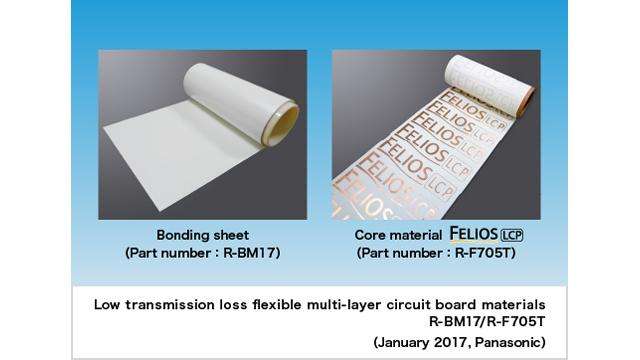Low transmission loss, flexible, multi-layer circuit board materials

Panasonic Corporation announced today that it has commercialized its low transmission loss flexible multi-layer circuit board materials, suitable for high-speed large-volume data transmission and thinner designs of mobile devices, including smartphones and tablet computers. The company will launch its mass production in January 2017. The combination of a liquid-crystal polymer (LCP) core material and a bonding sheet material that can be laminated at a low temperature and stored at room temperature will considerably ease the manufacture of high-frequency flexible multi-layer circuit boards.
Existing coaxial cables used for large-volume transmission are thick, so they present an obstacle to making mobile devices thinner. Low transmission loss flexible multi-layer circuit boards are of increasing potential as a solution that achieves both large-volume data transmission and a thin design, but they face many restrictions in how they should be handled, due to the characteristics of the materials they incorporate, so they require special facilities for manufacturing. Using its unique resin design technologies, Panasonic has developed a bonding sheet that can be laminated at a low temperature of less than 200 °C and stored at room temperature. This eliminates the need for special facilities for high-temperature lamination and refrigerated storage for bonding sheets. The company has also achieved high adhesiveness of LCP and low profile copper foil for the LCP core material by using its unique laminating techniques. Although existing flexible core materials using polyimide and so on are usable for only low-speed transmission, the new material, due to its low transmission loss property can also be used for high-speed transmission of large-volume data.
Panasonic's new flexible multi-layer circuit board materials have the following features:
- Low transmission loss and compatibility with USB 3.1 Gen 2 (10 Gbps) enable the transmission of large-volume data at higher speeds
- Transmission loss: -2 dB/100 mm @ 6 GHz.
- Core material: Dielectric constant: 2.9 @ 10 GHz, dissipation factor: 0.002 @ 10 GHz
- Bonding sheet: Dielectric constant: 2.2 @ 10 GHz, dissipation factor: 0.001 @ 10 GHz
- Flexible multi-layer circuit board adopts a 3-layer structure with multiple of signal lines at a thickness of 0.2 mm, allowing further thinning of mobile devices.
- Total board thickness: 0.2 mm or less
- Circuit board material that can be laminated at a low temperature and stored at room temperature makes manufacturing of flexible multi-layer circuit boards easier.
- Lamination temperature: 180 - 200°C, existing bonding sheet: 300°C
- Room-temperature storage: 23 (±5) °C, existing bonding sheet: refrigerated storage: 5°C or below
1. Low transmission loss and compatibility with USB 3.1 Gen 2 (10 Gbps) contribute to transmission of large-volume data at higher speeds
There is a growing need for faster transmission of signals due to the increasing volume of data demanded by the ever-higher resolutions of mobile device cameras and display screens. As a result, low transmission loss flexible multi-layer circuit boards that enable large-volume, high-speed transmission are of increasing interest as a replacement for currently-used coaxial cables; and low transmission loss, meaning that only a small amount of the signal is lost during transmission, is desired for the circuit board material. Panasonic has commercialized a low transmission loss core material and bonding sheet by applying its unique resin design technologies. It supports standards including USB 3.1 Gen 2 (10 Gbps) and will enable increased speed of large-volume data transmission in mobile devices.
2. Flexible multi-layer circuit board comprising a 3-layer, 0.2 mm-thick structure with multiple signal lines contributes to thinner mobile device designs
A coaxial cable is composed of one signal line in a cable and is capable of large-volume data transmission, but its downside is its thickness. A low transmission loss flexible multi-layer circuit board has several signal lines within it, so large-volume data transmission and a thinner design can be achieved simultaneously. Adopting this material allows flexible multi-layer circuit boards, in a 0.2 mm-thick, 3-layer structure that can carry several signal lines, to replace coaxial cables.
3. Circuit board material that can be laminated at a low temperature and stored at room temperature facilitates the manufacture of flexible multi-layer circuit boards
Previous bonding sheet, which forms the low transmission loss flexible multi-layer circuit boards with core material, had to be laminated at a high temperature or stored refrigerated. It was also difficult to handle, due to its material characteristics, and required special facilities that placed a burden on manufacturers. Using its unique resin design technologies, Panasonic has developed a bonding sheet that can be laminated at a low temperature of 200 °C or less, and stored at room temperature, making it far easier to handle the material during production. By providing this sheet and the low-transmission loss core material, the company will considerably facilitate the production of flexible multi-layer circuit boards.
Provided by Panasonic Corporation



















